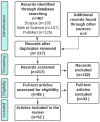Fifteen years with patient choice and free establishment in Swedish primary healthcare: what do we know?
- PMID: 35596549
- PMCID: PMC9578085
- DOI: 10.1177/14034948221095365
Fifteen years with patient choice and free establishment in Swedish primary healthcare: what do we know?
Abstract
Background: In 2007, a reform of Swedish primary healthcare began when some regions implemented enhanced patient choice in combination with free establishment for private providers. Although heavily debated, in 2010 it became mandatory for all regions to implement this choice system.
Aim: The aim of this article was to review all published research articles related to the primary healthcare choice reform in Sweden, to investigate what has been published about the reform and summarise its first 15 years.
Methods: A scoping review was performed to cover the breadth of research on the reform. Searches were made in Scopus, Web of Science and PubMed for articles published between 2007 and 2021, resulting in 217 unique articles. In total, 52 articles were included.
Results: The articles were summarised and presented in relation to six overarching themes: arguments about the primary healthcare choice reform; governance and financial reimbursements; choice of provider and use of information; effects on equity and access; effects on quality; and differences between private and public primary healthcare centres.
Conclusions: The articles show that the reform has led to an increase in access to primary healthcare, but most studies indicate that the increase is inequitably distributed in terms of socioeconomy and geographical location. The effects on quality are unclear but several studies show that the mechanisms supposed to lead to quality improvements do not work as intended. Furthermore, from a population health perspective, it is time to discuss how such a responsibility can be reintegrated into primary healthcare and function with the choice system.
Keywords: Patient choice; any willing provider laws; choice of healthcare provider; primary care; primary healthcare; scoping review.
Conflict of interest statement
The author(s) declared no potential conflicts of interest with respect to the research, authorship, and/or publication of this article.
Figures
Similar articles
-
Equity aspects of the Primary Health Care Choice Reform in Sweden - a scoping review.Int J Equity Health. 2017 Jan 28;16(1):29. doi: 10.1186/s12939-017-0524-z. Int J Equity Health. 2017. PMID: 28129771 Free PMC article.
-
Free establishment of primary health care providers: effects on geographical equity.BMC Health Serv Res. 2016 Jan 23;16:28. doi: 10.1186/s12913-016-1259-z. BMC Health Serv Res. 2016. PMID: 26803298 Free PMC article.
-
Simply the best? The impact of quality on choice of primary healthcare provider in Sweden.Health Policy. 2021 Nov;125(11):1448-1454. doi: 10.1016/j.healthpol.2021.09.009. Epub 2021 Sep 25. Health Policy. 2021. PMID: 34645569
-
Trajectories of primary health care utilization: a 10-year follow-up after the Swedish Patient Choice Reform of primary health care.BMC Health Serv Res. 2023 Nov 23;23(1):1294. doi: 10.1186/s12913-023-10326-9. BMC Health Serv Res. 2023. PMID: 37996861 Free PMC article.
-
Determinants of patient choice of healthcare providers: a scoping review.BMC Health Serv Res. 2012 Aug 22;12:272. doi: 10.1186/1472-6963-12-272. BMC Health Serv Res. 2012. PMID: 22913549 Free PMC article.
Cited by
-
Evaluating the impact of the 2010 Swedish choice reform in primary health care on avoidable hospitalization and socioeconomic inequities: an interrupted time series analysis using register data.BMC Health Serv Res. 2024 Aug 23;24(1):972. doi: 10.1186/s12913-024-11434-w. BMC Health Serv Res. 2024. PMID: 39174988 Free PMC article.
-
Contextualising the job demands-resources model: a cross-sectional study of the psychosocial work environment across different healthcare professions.Hum Resour Health. 2024 Nov 19;22(1):77. doi: 10.1186/s12960-024-00958-1. Hum Resour Health. 2024. PMID: 39563348 Free PMC article.
-
More or less equal? Trends in horizontal equity in mental health care utilization in Stockholm county, Sweden (2006-2022). Repeated survey-registry linked studies.Int J Equity Health. 2025 Apr 8;24(1):98. doi: 10.1186/s12939-025-02453-y. Int J Equity Health. 2025. PMID: 40200310 Free PMC article.
-
Universal health coverage and equal access in Sweden: a century-long perspective on macro-level policy.Int J Equity Health. 2024 May 28;23(1):111. doi: 10.1186/s12939-024-02193-5. Int J Equity Health. 2024. PMID: 38807180 Free PMC article.
-
Perceived discrimination and refraining from seeking physician's care in Sweden: an intersectional analysis of individual heterogeneity and discriminatory accuracy (AIHDA).Int J Equity Health. 2024 Oct 5;23(1):199. doi: 10.1186/s12939-024-02291-4. Int J Equity Health. 2024. PMID: 39367379 Free PMC article.
References
-
- Magnussen JP, Vrangbæk K, Saltman RB. Nordic health care systems: recent reforms and current policy challenges. Maidenhead, UK: Open University Press, 2009.
Publication types
MeSH terms
LinkOut - more resources
Full Text Sources


